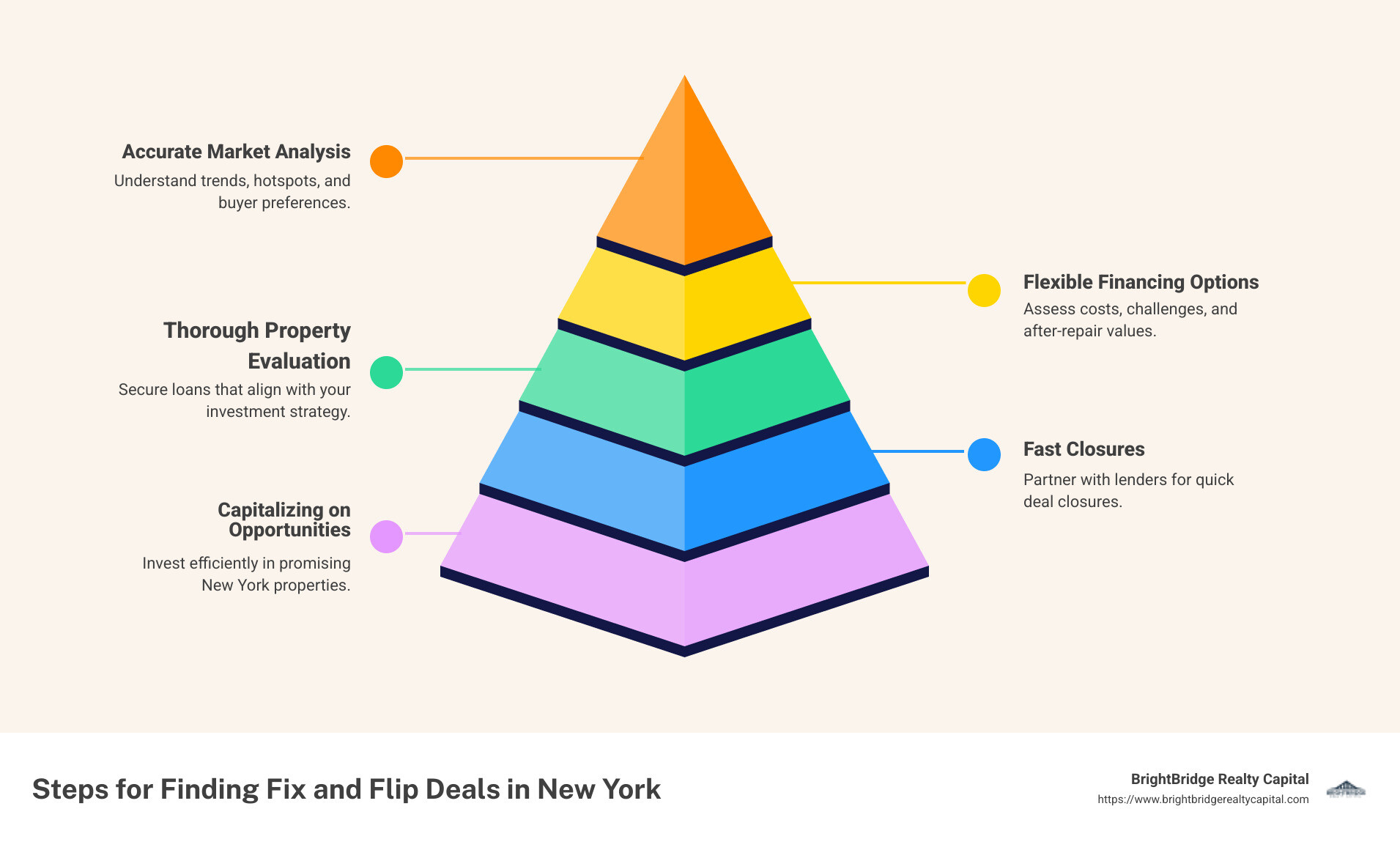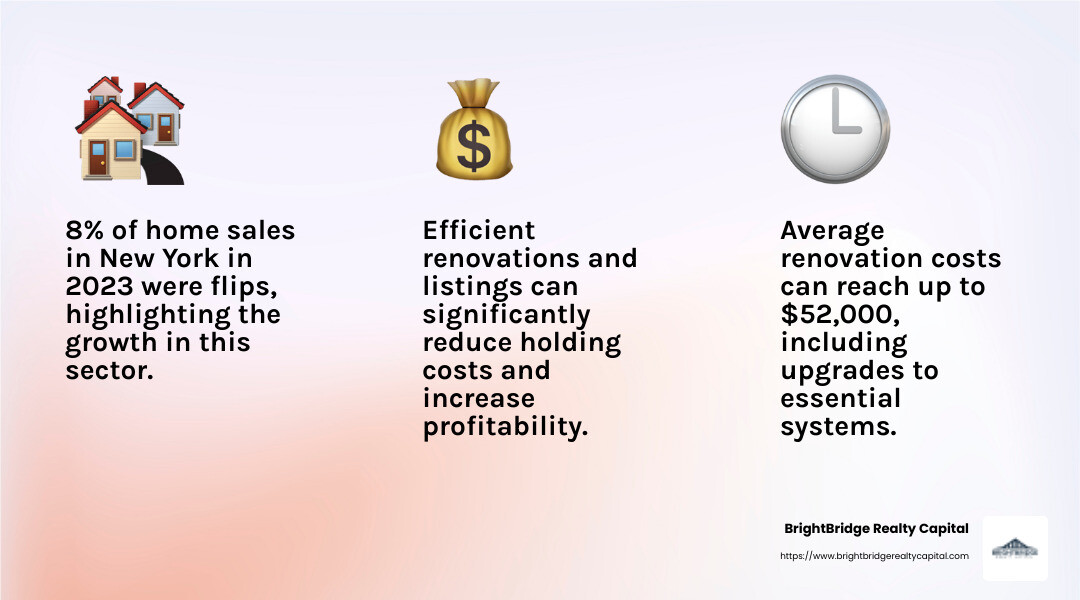The Easiest Way to Find Fix and Flip Deals in New York

Fix and flip New York presents a dynamic investment opportunity for savvy real estate investors just like you. But here’s the million-dollar question: How do you find those hidden gems that promise substantial profits? Simple: Understand the nuances of the New York real estate market, and leverage financing options custom for quick acquisitions and profitable turnovers.
Real estate investors looking to dive into the fix and flip market in New York should focus on:
- Accurate Market Analysis: Know the trends, the hotspots, and the buyer preferences.
- Financing Options: Aim for flexible loan choices that suit your pace and strategy.
- Property Evaluation: Grasp the true potential by assessing costs, possible challenges, and after-repair values.
- Fast Closures: Choose lenders who can help you seize profitable deals quickly.
Efficiently navigating these facets allows you to capitalize on some of the best investment opportunities waiting in the thriving New York real estate scene.

Understanding Fix and Flip New York
The fix and flip New York market is busy with opportunities, but understanding its dynamics is crucial for success. Here's a breakdown of what you need to know:
The Real Estate Market
New York's real estate market is diverse and competitive. In 2023, 8% of home sales were flips, highlighting the growing opportunity in this sector. Focus on areas like Buffalo, Queens, and Long Island, where flipping has shown promising returns. The key is to study local market trends and buyer preferences. This knowledge helps you identify the best neighborhoods for investment.
Property Renovation
Renovation is at the heart of a successful fix and flip. The average renovation cost in New York can reach up to $52,000. This includes upgrades to roofing, plumbing, and electrical systems. Efficient renovation not only improves the property's value but also attracts potential buyers quickly. Always conduct a thorough home inspection to uncover hidden issues that could inflate costs.
Quick Sale
A speedy sale is essential to maximize profits and minimize holding costs. Listing your property on the MLS can expose it to a broader audience, increasing your chances of a quick sale. Consider using flat fee MLS services to save on agent commissions, which can eat into your profits.

By keeping a pulse on the market, managing renovation costs wisely, and ensuring a swift sale, you can successfully steer the fix and flip New York landscape. This sets the stage for profitable investments and a flourishing real estate portfolio.
Steps to Find the Best Fix and Flip Deals
Finding the right property is the first step in a successful fix and flip New York venture. Here's how to identify and evaluate potential deals:
Identifying Potential Properties
Distressed Properties: These are homes in poor condition, often priced below market value. They offer a great opportunity for flippers to buy low and sell high after renovations.
Foreclosures and REOs (Real Estate Owned): Banks sell foreclosed homes, often at a discount, to recover their loan amounts. REOs are properties that didn't sell at foreclosure auctions and are now owned by the bank. Both can be excellent sources for bargain deals.
MLS and Off-Market Listings: The Multiple Listing Service (MLS) is a valuable resource for finding properties. However, off-market deals, found through networking or direct outreach, can sometimes offer less competition and better prices.
Evaluating Profit Potential
After-Repair Value (ARV): This is the estimated value of the property after renovations. Knowing the ARV helps you determine if a property is worth investing in. Look at comparable sales in the area to estimate this value.
Renovation Costs: Accurately estimate the costs involved in renovating the property. This includes labor, materials, and any unexpected repairs. On average, renovation costs in New York can reach up to $52,000.
Return on Investment (ROI): Calculate the ROI to assess the potential profitability of the deal. A good rule of thumb is the 70% rule, which suggests that you should pay no more than 70% of the ARV minus renovation costs.
By focusing on these aspects, you can effectively zero in on the most promising fix and flip New York opportunities. This approach ensures that your investments are not only profitable but also sustainable in the long run.
Next, let's explore how to finance your fix and flip projects efficiently.
Financing Your Fix and Flip Projects
Navigating financing options is crucial to the success of your fix and flip New York venture. Understanding the available loans and their requirements can help you secure the best deal.
Fix and Flip Loan Requirements
Loan-to-Value (LTV): Most lenders in New York offer a maximum LTV of 70% for fix and flip projects. This means they will lend up to 70% of the property's after-repair value (ARV). This ensures that both you and the lender have a stake in the property's success.
Cash Reserves: Lenders typically require you to have cash reserves to cover a portion of the purchase price and renovation costs. For example, you may need to contribute 10%-20% of the purchase price from your own funds.
Creditworthiness: While hard money loans prioritize the property's potential over your credit score, having a good credit history can still improve your loan terms. Lenders may also look at your previous experience with similar projects.
BrightBridge Realty Capital's Financing Solutions
BrightBridge Realty Capital offers flexible financing solutions to meet your fix and flip needs. Here's how they stand out:
Short-Term Loans: BrightBridge provides short-term loans custom for fix and flip projects, allowing you to renovate and sell properties quickly.
Hard Money Loans: These loans focus on the property's value rather than your credit score, making them ideal for investors with limited credit history.
Fast Closings: With industry-leading table funding platforms, BrightBridge ensures quick closings so you can start your project without delay.
Direct Lending: As a direct lender, BrightBridge eliminates intermediaries, offering more competitive rates and personalized service.
Competitive Rates: Their rates are designed to maximize your profit margins, ensuring your investment is as lucrative as possible.
By partnering with BrightBridge Realty Capital, you can secure the funding you need to capitalize on New York's real estate opportunities efficiently.
Next, we'll dig into the nuances of navigating the New York real estate market, including local regulations and market trends.
Navigating the New York Real Estate Market
To succeed in the fix and flip New York market, you need to understand local regulations, keep an eye on market trends, and adopt effective investment strategies. Here's how you can steer these crucial aspects:
Local Regulations
New York's real estate market is governed by a complex web of regulations. These rules can vary significantly between the city and the surrounding suburbs. Key regulations to be aware of include:
Zoning Laws: Ensure your renovation plans comply with local zoning laws, which dictate how properties can be used. Violating these can lead to costly fines or project delays.
Building Codes: Familiarize yourself with New York's building codes. These codes ensure safety and quality standards are met during renovations. Non-compliance can result in penalties or even the need to redo work.
Permitting Requirements: Before starting any renovation, secure the necessary permits. New York City, in particular, has stringent permitting processes that can impact project timelines.
Market Trends
The New York real estate market is dynamic, with trends that can impact your investment strategy. Keeping up with these trends is essential:
Rising Home Prices: As of Q2 2024, the median home price in New York was around $550,700. This trend is expected to continue, offering opportunities for substantial profits on flips.
High Demand Areas: Cities like New York City, Long Beach, and Auburn have shown significant growth in home sale prices, making them attractive for investors seeking high returns.
Competitive Markets: Areas like Henrietta and Arcadia are highly competitive, with homes selling quickly. Identifying such markets can help you secure properties that are likely to appreciate rapidly.
Investment Strategies
To maximize your fix and flip New York investments, consider these strategies:
Target Distressed Properties: Focus on foreclosures, REOs, and other distressed properties. These can often be purchased below market value, increasing your potential profit margin.
Use the 70% Rule: This rule suggests not paying more than 70% of a property's after-repair value (ARV) minus renovation costs. This helps ensure a healthy profit margin.
Optimize Renovations: Prioritize renovations that add the most value. Kitchens, bathrooms, and curb appeal improvements often offer the highest returns.
By understanding these regulations, trends, and strategies, you'll be better equipped to steer the New York real estate market and capitalize on its opportunities.
Next, we'll address some frequently asked questions about fix and flip projects in New York.
Frequently Asked Questions about Fix and Flip New York
What are the typical loan terms for fix and flip projects?
For fix and flip New York projects, typical loan terms are short-term, often ranging from 12 to 24 months. These loans are designed to cover both the purchase and renovation costs of a property. Interest rates can vary, but they are generally higher than traditional mortgages due to the short-term nature and higher risk involved. For example, loans may have interest rates starting around 7.75%, with terms like interest-only payments to keep monthly costs manageable.
How quickly can I close on a fix and flip loan?
Speed is crucial in the fix and flip New York market. Many lenders, like BrightBridge Realty Capital, offer fast closings to help investors compete with cash buyers. It is possible to close on a fix and flip loan in as little as 7 to 14 days. This quick turnaround is ideal for investors looking to seize opportunities in competitive markets.
What types of properties are best for fix and flip investments?
When considering fix and flip New York investments, focus on properties that promise high returns. These often include:
Distressed Properties: Look for foreclosures, REOs, and properties in need of significant renovation. These can be purchased below market value, offering a higher potential profit margin.
Single-Family Homes: These are popular for flipping due to their broad market appeal and relatively straightforward renovation processes.
Properties in High-Demand Areas: Focus on locations like New York City, Long Beach, and Auburn, where the demand for homes is high, and prices are rising. These areas offer better chances of selling quickly and at a higher price.
Understanding these aspects can help you make informed decisions and maximize your investment's success.
Next, we'll explore more about how BrightBridge Realty Capital can support your fix and flip endeavors.
Conclusion
Starting on a fix and flip New York journey can be a lucrative venture, especially in a dynamic real estate market like New York. With careful planning and the right strategies, you can turn distressed properties into profitable investments.
BrightBridge Realty Capital is your reliable partner in this endeavor. We offer custom financing solutions that cater to the unique needs of real estate investors. Our fast closings and direct lending approach ensure you can act swiftly in competitive markets. With us, you gain access to competitive rates and a seamless process that eliminates the usual problems of securing funding.
The New York real estate market is full of opportunities. From foreclosures to properties in high-demand areas, there are numerous chances to maximize returns. By leveraging our expertise and resources, you can steer this market with confidence and increase your chances of investment success.
Let BrightBridge Realty Capital help you open up the potential of your next fix and flip project. Together, we can transform real estate opportunities into rewarding ventures.


